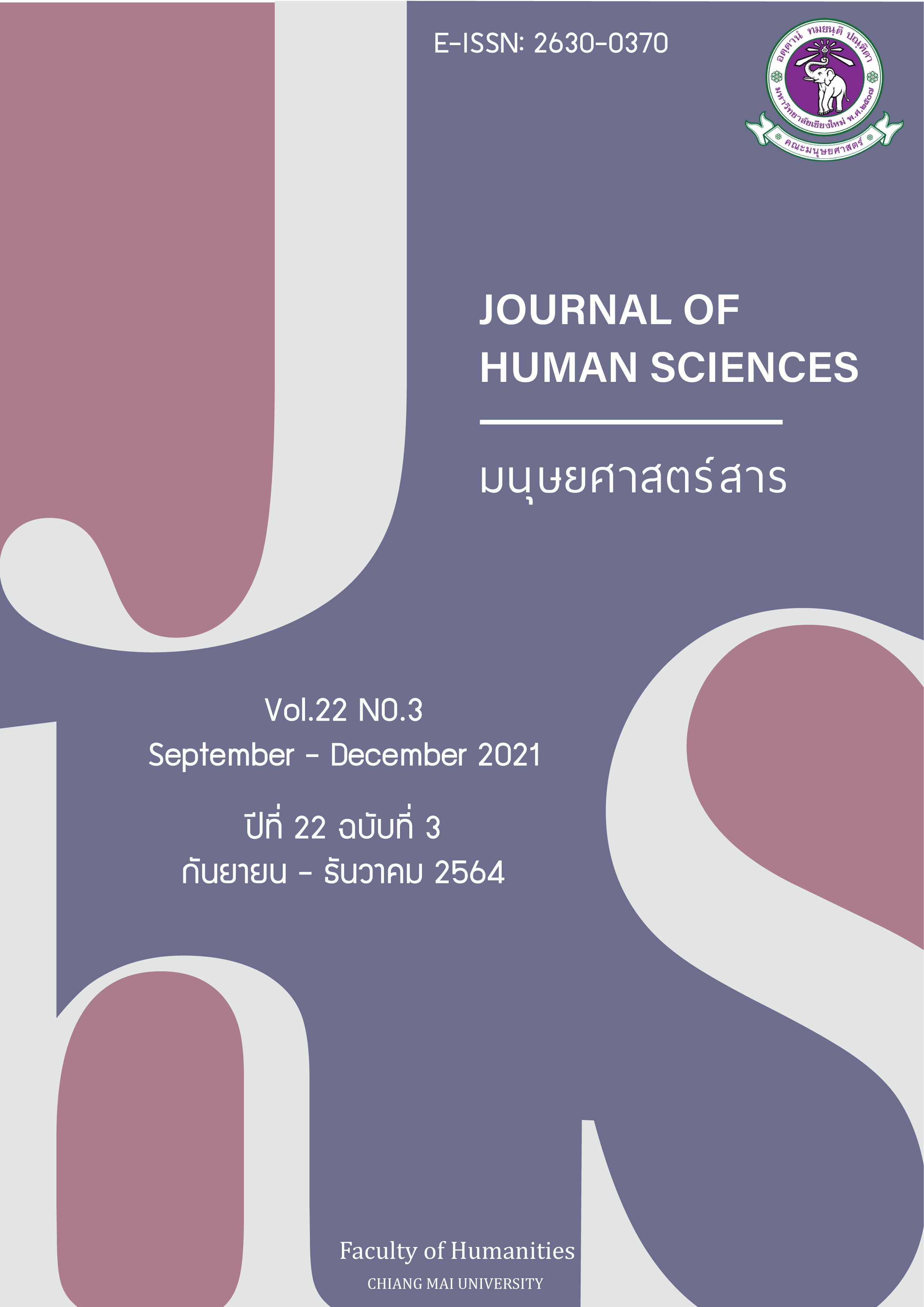อวจนภาษาแห่งความน่าสงสาร: ทัศนคติความรู้สึกน่าสงสารต่อการสื่อสารผ่านอวจนภาษาของขอทานในเขตกรุงเทพมหานครของกลุ่มคนใน 3 ช่วงวัย Beggars in Bangkok
Main Article Content
บทคัดย่อ
งานวิจัยเรื่องอวัจนภาษาแห่งความน่าสงสาร: ขอทานในกรุงเทพฯ มีวัตถุประสงค์เพื่อ (1) สำรวจและจำแนกรูปแบบการสื่อสารผ่านอวัจนภาษาของขอทานในเขตกรุงเทพมหานคร (2) สำรวจพฤติกรรมการให้ทานของกลุ่มตัวอย่างในเขตกรุงเทพมหา-นคร และ (3) เพื่อสำรวจผลของการสื่อสารผ่านอวัจนภาษารูปแบบต่างๆของขอทานในกรุงเทพมหานครต่อความรู้สึกน่าสงสารของกลุ่มตัวอย่างในช่วงอายุต่างๆ
งานวิจัยชิ้นนี้ใช้วิธีการเก็บข้อมูลด้วยการผสานวิธี โดยผู้วิจัยดำเนินการเก็บข้อมูลด้วยการวิจัยเชิงคุณภาพ ด้วยวิธีการสังเกตแบบไม่มีส่วนร่วม เพื่อรวบรวมลักษณะการสื่อสารผ่านอวัจนภาษาของขอทานในเขตกรุงเทพมหานคร จากนั้นดำเนินการสร้างแบบสำรวจเพื่อเก็บข้อมูลด้วยการวิจัยเชิงปริมาณผ่านแบบสำรวจจากกลุ่มตัวอย่างใน 3 ช่วงอายุ ได้แก่ ช่วงอายุ 10 – 24 ปี ช่วงอายุ 24.01 – 40 ปี และช่วงอายุ 40.01 – 55 ปี จำนวนทั้งสิ้น 406 คน โดยผู้วิจัยนำเสนอข้อมูลทั้งในรูปแบบสถิติเชิงบรรยาย และสถิติเชิงอนุมาน ด้วยการวิเคราะห์ความแปรปวนทางเดียว (One – Way ANOVA) และการทดสอบความแตกต่างระหว่างกลุ่ม (T -Test)
ผลการวิจัยพบว่า การสื่อสารผ่านอวัจนภาษาของขอทานในกรุงเทพสามารถจำแนกได้ทั้งสิ้น 25 ลักษณะ โดยสามารถจัดเข้าเป็น 8 รูปแบบของการสื่อสารผ่านอวัจนภาษา ได้แก่ การสื่อสารผ่านลักษณะที่ปรากฏ การสื่อสารผ่านสิ่งของหรืออุปกรณ์อื่นๆ การสื่อสารผ่านภาษากายและการเคลื่อนไหว การสื่อสารผ่านน้ำเสียง การสื่อสารผ่านช่วงเวลา การสื่อสารผ่านสภาพแวดล้อม การสื่อสารผ่านการสัมผัส และการสื่อสารผ่านระยะห่าง ทั้งนี้ กลุ่มตัวอย่างมีพฤติกรรมในการให้ทานคือ กว่าร้อยละ 60 มีพฤติกรรมในการให้ทานโดยเฉลี่ยน้อยกว่า 4 ครั้งต่อเดือน ร้อยละ 36 มักมีการให้ทานโดยเฉลี่ยอยู่ที่ 5.25 – 10 บาทต่อครั้ง และเหตุผลหลักในการให้ทานคือความสงสาร ความเวทนาและต้องการช่วยเหลือ มากกว่าแนวคิดเรื่องบาปบุญคุณโทษ โดยเมื่อพิจารณาผลของการสื่อสารผ่านอวัจนภาษาของขอทานต่อความรู้สึกน่าสงสารของกลุ่มตัวอย่างพบว่า การสื่อสารผ่านลักษณะที่ปรากฏส่งผลต่อความรู้สึกน่าสงสารสูงกว่าการอวัจนภาษารูปแบบอื่นๆอย่างมีนัยยะสำคัญทางสถิติที่ระดับ 0.05 แนวโน้มของระดับความรู้สึกน่าสงสารของกลุ่มตัวอย่างทั้ง 3 ช่วงอายุ เป็นไปในทิศทางเดียวกันจากอวัจนภาษาทั้ง 8 รูปแบบ คือ กลุ่มตัวอย่างที่มีอายุ 10 – 24 ปี มีค่าเฉลี่ยระดับความรู้สึกน่าสงสารสูงสุด รองลงมาคือกลุ่มตัวอย่างช่วงอายุ 24.01 – 40 ปี และกลุ่มตัวอย่างอายุ 40.01 – 55 ปีน้อยที่สุดตามลำดับ โดยพบว่า 5 ใน 8 รูปแบบการสื่อสารอวัจนภาษาได้แก่ การสื่อสารผ่านสิ่งของหรืออุปกรณ์อื่นๆ การสื่อสารผ่านภาษากาย การสื่อสารผ่านน้ำเสียง การสื่อสารผ่านสภาพแวดล้อม และการสื่อสารผ่านการสัมผัส ส่งผลต่อระดับความรู้สึกน่าสงสารที่ต่างกันระหว่างกลุ่มตัวอย่าง โดยกลุ่มอายุ 40.01 – 55 ปี มีระดับความรู้สึกน่าสงสารน้อยกว่าอีกสองกลุ่มอย่างมีนัยยะสำคัญทางสถิติที่ 0.05 อีกด้วย หน่วยงานที่มีส่วนเกี่ยวข้องกับการแก้ไขปัญหาขอทาน ควรดำเนินการประชาสัมพันธ์ความรู้ และความเข้าใจเกี่ยวกับขอทานและการให้ทานแก่ประชาชนในช่วงอายุ 10 – 24 ปี และ 24 – 40 ปีเป็นพิเศษ
Article Details

อนุญาตภายใต้เงื่อนไข Creative Commons Attribution-NonCommercial-NoDerivatives 4.0 International License.
เอกสารอ้างอิง
ณิชชา บูรณสิงห์. (2558). ปัญหาขอทานเด็ก: ผลพวงของการพัฒนาที่ไม่สมดุล. เข้าถึงเมื่อ 11 ตุลาคม 2563. https://library2.parliament.go.th/ebook/content-issue/2558/hi2558-064.pdf.
ดวงพร จอมเกตุ. (2556). ปัญหาขอทานอาชญากรรมบนความเวทนา. เข้าถึงเมื่อ 11 ตุลาคม 2563. http://sd-group1.blogspot.com/2013/01/53241912_13.html.
ไทยรัฐออนไลน์. (2561). ยอดปี 60 คนเร่ร่อน-ไร้ที่พึ่ง ขยับเพิ่ม เหตุเศรษฐกิจครัวเรือนย่ำแย่. เข้าถึงเมื่อ 11 ตุลาคม 2563. https://www.thairath.co.th/news/society/1218810.
มนันญา ภู่แก้ว. (ม.ป.ป.). ธุรกิจบาป...ขอทานไทย. เอกสารอัดสำเนา.
รู้ทัน! สถานการณ์ขอทานปี 2559 เท่าทัน “ต่างด้าว” หากินบนความใจดีคนไทย. หนังสือพิมพ์มติชน. วันที่ 28 เมษายน 2559. หน้า 23.
Baran, S. J. and Davis, D. K. (2012). Mass communication theory: Foundations, ferment, and future. 6th Edition. Canada: Wadsworth Cengage Learning.
Littlejohn, S. W. and Foss, K. A. (2008). Theories in human communication. 9th Edition. Canada: Wadsworth Cengage Learning.
Wilson, G. (2016). Body language. UK: Icon Books Ltd.
Wood, T. J. (2009). Communication in our lives. 5th Edition. USA: Wadsworth Cengage Learning.


